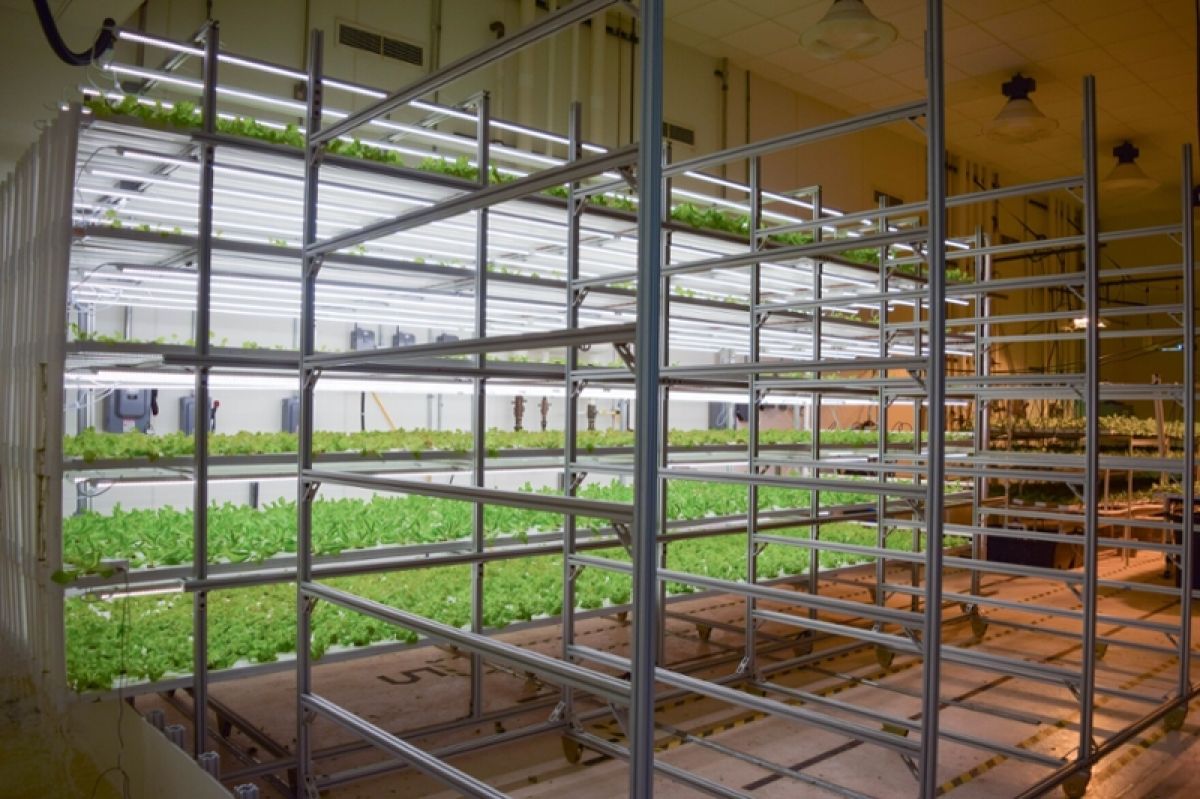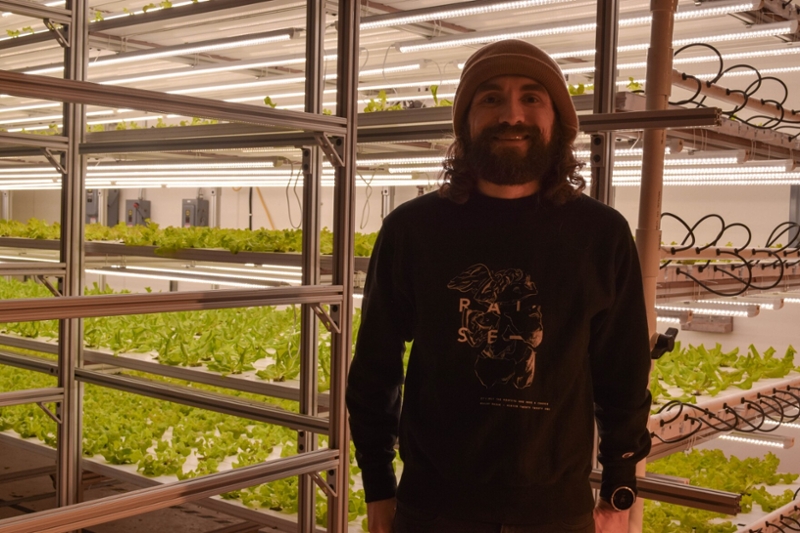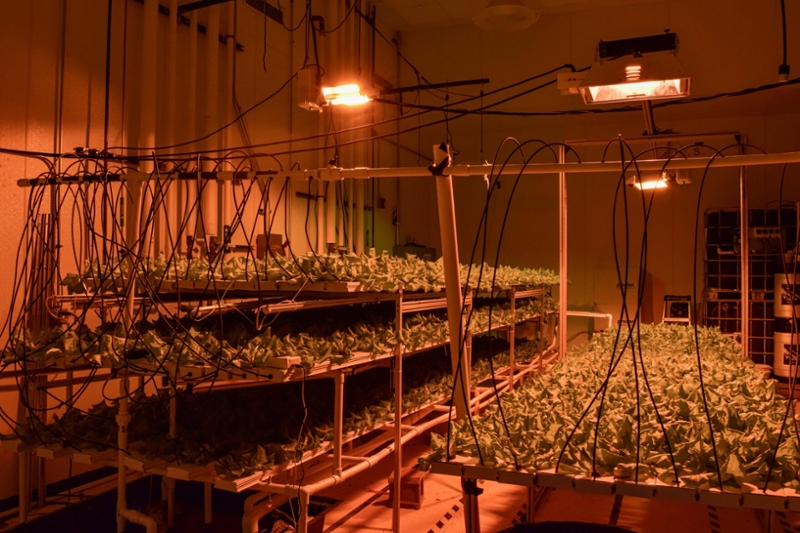
Lettuce grows in rows stacked on top of each other and bathes under strips of LED lighting at Nebullam in Ames, Iowa. ( Katie Peikes / Harvest Public Media)
People who subscribe to the Ames, Iowa, company Nebullam get a bag of fresh produce delivered directly to their doorstep. Leafy greens or cherry tomatoes that were harvested at most three hours ago.
The food isn’t just local. It’s grown indoors.
Rows of plants are stacked on top of each other in an industrialized room in the Iowa State University Research Park, in what’s called a vertical farm. Nebullam controls the lighting, water and temperature to create ideal conditions to grow fresh produce year-round.
The plants get all the nutrients they need to thrive. No more, no less.
And there are no pesticides used because there are no bugs. The CEO jokes that the only bugs Nebullam has to deal with are software-related.
The plants soak up artificial sunlight through ever-more-advanced LEDs.
Yet those LEDs also put the eco-friendliness of vertical farming in a jam. The light requires electricity that — despite growth in renewable energy sources like wind power — comes largely from fossil fuels that belch greenhouse gases into the atmosphere.
Nebullam's origin
Co-founder and CEO Clayton Mooney said he sees a lot of benefits to vertical farming.
“There are fewer steps to actually get fresh, healthier food to someone,” Mooney said. “We can grow closer to the consumer. Because we can control the environment, there’s a lot less waste from our side.”
Mooney said Nebullam is mostly focused on leafy greens because other crops, like corn, would be more expensive to grow in this environment.
Nebullam has been around since 2017. Mooney said the company started out wanting to be a technology provider to new and expanding indoor farms. It also sold lettuce to local restaurants and grocers.
But when the coronavirus pandemic began in 2020, its mission evolved, and the company started selling and delivering lettuce directly to consumers on a subscription basis. Nebullam delivers to consumers in central and eastern Iowa: Ames, Ankeny, Des Moines, Cedar Rapids, Coralville and Iowa City.

Roughly 40,000 plants grow in a 1,000-square-foot space at the vertical farm. Nebullam keeps the room temperature between 65 and 68 degrees year-round. Mooney said any water the plants don’t use is recycled back into the system.
“For every month we grow plants in our growing equipment, we save one year’s worth of water when compared to traditional methods,” Mooney said.
Nebullam uses significantly less land than traditional agriculture. But vertical farms mimic sunlight with artificial lights, and that takes energy.
Nebullam’s plants bathe under strips of LED lighting that shine 12 hours a day.
A lot of energy
Yet artificial lighting is vertical farming’s biggest problem. Jonathan Foley, the executive director of Project Drawdown, a nonprofit that researches climate solutions, said outfitting an indoor space to be like an outdoor farm gobbles up energy.
“The environmental benefits are largely washed away by the enormous energy it takes to grow this kind of food,” he said.
Vertical farming doesn’t solve an environmental problem, Foley said. Rather, he called it a “small-niche market” to grow fresh greens, especially in colder climates.
“But when it’s pretending to be like an environmental salvation is where I’m going, ‘wait a minute,’” Foley said. “These vertical farms take an enormous amount of material to build and energy to run, and we couldn’t possibly feed a significant fraction of the world this way.”
On average, vertical farms release more carbon dioxide into the atmosphere than conventional farming because of their energy use. According to a report, the average vertical farm uses about 18 kilowatt-hours to produce 1 pound of lettuce. Nebullam’s energy use is lower, taking the company 8 kilowatt-hours to produce 1 pound of lettuce, Mooney said.
Because vertical farms are centered in urban areas, the food travels shorter distances to customers. Nebullam’s produce travels an average of 18 miles to consumers.
Researchers debate how much transportation figures into the overall emissions of food grown outdoors. Iowa State University agricultural and biosystems engineering professor Kurt Rosentrater said it matters.
“The environmental impacts from transportation, generally speaking, are pretty on par or even slightly more than what happens in the field itself,” Rosentrater said.
Rosentrater said the farther food travels, the more emissions it’s going to have. He said researchers factor a lot of different things into the carbon footprint of agriculture, including the emissions of bringing seed to a production facility, production, transportation, how much water is used, manual labor versus gasoline- or diesel-powered tractors, and fertilizer.
Still, a pound of lettuce grown at Nebullam would have more than five times the carbon footprint of lettuce grown outdoors in Arizona and shipped to Ames, Iowa.
Nebullam’s production emits about 6 pounds of carbon dioxide into the atmosphere for a pound of lettuce. Harvest Public Media got this number by multiplying the company’s 8 kilowatt-hours per pound of lettuce by 0.78 pounds per kilowatt-hour of carbon dioxide emissions in Iowa’s 2020 electricity profile.
But lighting efficiency has advanced over the years, said Ricky Stephens, the director of digital strategy at urban farm consulting firm Agritecture. Stephens said that’s making vertical farming more financially viable.
“Vertical farms that are using the latest LED technology will use less energy, fewer kilowatt-hours per pound of final product, compared to five or 10 years ago with the technology available then,” he said. “But it's still quite high.”
Stephens said cultivating produce indoors makes it possible to grow food even as climate change brings on extreme heat, drought and flooding. But the high energy consumption means vertical farming is also contributing to climate change.
“It’s a bit of a conundrum for the industry and something that we're hoping to see more transparency and honesty about,” Stephens said

Mooney, the Nebullam CEO, said the vertical farming industry recognizes it needs to trim its energy use. And it’s making progress. But he said what Nebullam is doing now to grow its leafy greens is working. The company has more than 300 subscribers.
“Our produce lasts four times longer than store-bought produce. And that's because it's the same day harvest and delivery,” Mooney said. “We're really proud of that.”
Mooney said ultimately, Nebullam’s vision is to replace the produce aisle. The company is looking to launch two other indoor farms inside and outside of Iowa this year.













